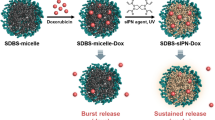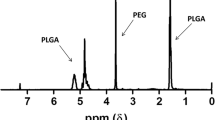ABSTRACT
Purpose
To investigate the influences of stability of doxorubicin (DOX) retained in PEG-PE/HSPC micelles on its biodistribution, toxicity and anti-tumor activity in mice.
Methods
We incorporated HSPC into PEG-PE micelles at various molar ratios by a self-assembly procedure. Micelles were characterized by dynamic light scattering, transmission electron microscope, atomic force microscopy. Agarose gel electrophoresis assay was used to detect stable retention of DOX in micellar preparations. Biodistribution, toxicity and anti-tumor activity of doxorubicin encapsulated in PEG-PE/HSPC micelles in mice were investigated.
Results
HSPC incorporation not only changed the size and shape of PEG-PE micelles, but also decreased the ability of DOX stable retained in PEG-PE micelles, resulting in a great discrepancy in biodistribution, toxicity and anti-tumor activity among micellar DOX preparations. DOX encapsulated in PEG-PE micelles (M1-DOX), with narrower size distribution and greater stability, demonstrated better cytotoxicity in vitro and low systemic toxicity with superior anti-tumor metastasis activity in vivo.
Conclusions
Encapsulation of DOX into PEG-PE micelles showed the best therapeutic activity and lowest systemic toxicity compared to other HSPC-incorporated PEG-PE micellar preparations. Stable retention of drugs within micelles is important and is determined by compatibility between drugs and polymer blocks.








Similar content being viewed by others
REFERENCES
Davis ME, Chen ZG, Shin DM. Nanoparticle therapeutics: an emerging treatment modality for cancer. Nat Rev Drug Discov. 2008;7:771–82.
Peer D, Karp JM, Hong S, Farokhzad OC, Margalit R, Langer R. Nanocarriers as an emerging platform for cancer therapy. Nat Nanotechnol. 2007;2:751–60.
Maeda H, Wu J, Sawa T, Matsumura Y, Hori K. Tumor vascular permeability and the EPR effect in macromolecular therapeutics: a review. J Contr Release. 2000;65:271–84.
Byrne JD, Betancourt T, Brannon-Peppas L. Active targeting schemes for nanoparticle systems in cancer therapeutics. Adv Drug Deliv Rev. 2008;60:1615–26.
Sawant RR, Torchilin VP. Polymeric micelles: polyethylene glycol-phosphatidylethanolamine (PEG-PE)-based micelles as an example. Meth Mol Biol. 2010;624:131–49.
Nishiyama N, Morimoto Y, Jang WD, Kataoka K. Design and development of dendrimer photosensitizer-incorporated polymeric micelles for enhanced photodynamic therapy. Adv Drug Deliv Rev. 2009;61:327–38.
Torchilin VP. Structure and design of polymeric surfactant-based drug delivery systems. J Contr Release. 2001;73:137–72.
Lukyanov AN, Gao Z, Mazzola L, Torchilin VP. Polyethylene glycol-diacyllipid micelles demonstrate increased acculumation in subcutaneous tumors in mice. Pharm Res. 2002;19:1424–9.
Weissig V, Whiteman KR, Torchilin VP. Accumulation of protein-loaded long-circulating micelles and liposomes in subcutaneous Lewis lung carcinoma in mice. Pharm Res. 1998;15:1552–6.
Tang N, Du G, Wang N, Liu C, Hang H, Liang W. Improving penetration in tumors with nanoassemblies of phospholipids and doxorubicin. J Natl Cancer Inst. 2007;99:1004–15.
Wang Y, Wang R, Lu X, Lu W, Zhang C, Liang W. Pegylated phospholipids-based self-assembly with water-soluble drugs. Pharm Res. 2010;27:361–70.
Rijcken CJ, Snel CJ, Schiffelers RM, van Nostrum CF, Hennink WE. Hydrolysable core-crosslinked thermosensitive polymeric micelles: synthesis, characterisation and in vivo studies. Biomaterials. 2007;28:5581–93.
Yokoyama M, Fukushima S, Uehara R, Okamoto K, Kataoka K, Sakurai Y, Okano T. Characterization of physical entrapment and chemical conjugation of adriamycin in polymeric micelles and their design for in vivo delivery to a solid tumor. J Contr Release. 1998;50:79–92.
Talelli M, Iman M, Varkouhi AK, Rijcken CJ, Schiffelers RM, Etrych T, et al. Core-crosslinked polymeric micelles with controlled release of covalently entrapped doxorubicin. Biomaterials. 2010;31:7797–804.
Hristova K, Needham D. Phase behavior of a lipid/polymer-lipid mixture in aqueous medium. Macromolecules. 1995;28:991–1002.
Ashok B, Arleth L, Hjelm RP, Rubinstein I, Onyüksel H. In vitro characterization of PEGlyated phospholipids micelles for improved drug solubilization: effects of PEG chain length and pc incorporation. J Pharm Sci. 2004;93:2476–87.
Arleth L, Ashok B, Onyuksel H, Thiyagarajan P, Jacob J, Hjelm RP. Detailed structure of hairy mixed micelles formed by phosphatidylcholine and PEGlyated phospholipids in aqueous media. Langmuir. 2005;21:3279–90.
Mayer LD, Bally MB, Loughrey H, Masin D, Cullis PR. Liposomal vincristine preparations which exhibit decreased drug toxicity and increased activity against murine L1210 and P388 tumors. Cancer Res. 1990;50:575–9.
Charrois GJ, Allen TM. Drug release rate influences the pharmacokinetics, biodistribution, therapeutic activity, and toxicity of pegylated liposomal doxorubicin formulations in murine breast cancer. Biochim Biophys Acta. 2004;1663:167–77.
Luecke RH, Ryan MP, Wosilait WD. A mathematical model and computer program for adriamycin distribution and elimination. Comput Meth Programs Biomed. 1985;20:23–31.
Hershman DL, McBride RB, Eisenberger A, Tsai WY, Grann VR, Jacobson JS. Doxorubicin, cardiac risk factors, and cardiac toxicity in elderly patients with diffuse B-cell non-Hodgkin’s lymphoma. J Clin Oncol. 2008;26:3159–65.
van Hoesel QG, Steerenberg PA, Crommelin DJ, van Oort W, Klein S, Douze JM, et al. Reduced cardiotoxicity and nephrotoxicity with preservation of antitumor activity of doxorubicin entrapped in stable liposomes in the LOU/M Wsl rat. Cancer Res. 1984;44:3698–705.
Yagmurca M, Bas O, Mollaoglu H, Sahin O, Nacar A, Karaman O, Songur A. Protective effects of erdosteine on doxorubicin-induced hepatotoxicity in rats. Arch Med Res. 2007;38:380–5.
Injac R, Strukelj B. Recent advances in protection against doxorubicin-induced toxicity. Technol Cancer Res Treat. 2008;7:15–26.
Bertani T, Poggi A, Pozzoni R, Delaini F, Sacchi G, Thoua Y, et al. Adriamycin-induced nephrotic syndrome in rats: sequence of pathologic events. Lab Invest. 1982;46:16–23.
Weening JJ, Rennke HG. Glomerular permeability and polyanion in adriamycin nephrosis in the rat. Kidney Int. 1983;24:152–9.
Jaenke RS, Fajardo LF. Adriamycin-induced myocardioal lesions: report of a workshop. Am J Sur Pathol. 1977;1:55–60.
Philips FS, Giladoga A, Marrouardt H, Sternberg SS, Vidal PM. Some observations on the toxicity of adriamycin (NSC-123127). Cancer Chemother Rep. 1975;59:177–81.
van Hoesel QG, Steerenberg PA, Vos JG, Hillen FC, Dormans JA. Antitumor effect, cardiotoxicity, and nephrotoxicity of doxorubicin in the IgM solid immunocytoma-bearing LOU/M/WSL rat. J Natl Cancer Inst. 1984;72:1141–50.
ACKNOWLEDGMENTS & DISCLOSURES
This work was supported by grants from State Key Development Plan Project (2007CB935801), the National Nature Sciences Foundation of China (30901869).
Dr Junfeng Hao of the IBP core facilities centre was gratefully thanked for her help for Histopathology and TUNEL assay.
Author information
Authors and Affiliations
Corresponding authors
Additional information
Xiuli Wei and Yiguang Wang contributed equally to this work.
Rights and permissions
About this article
Cite this article
Wei, X., Wang, Y., Zeng, W. et al. Stability Influences the Biodistribution, Toxicity, and Anti-tumor Activity of Doxorubicin Encapsulated in PEG-PE Micelles in Mice. Pharm Res 29, 1977–1989 (2012). https://doi.org/10.1007/s11095-012-0725-5
Received:
Accepted:
Published:
Issue Date:
DOI: https://doi.org/10.1007/s11095-012-0725-5




